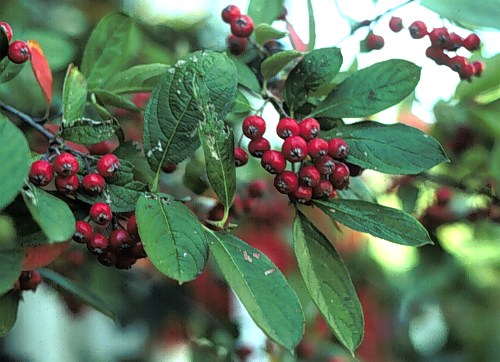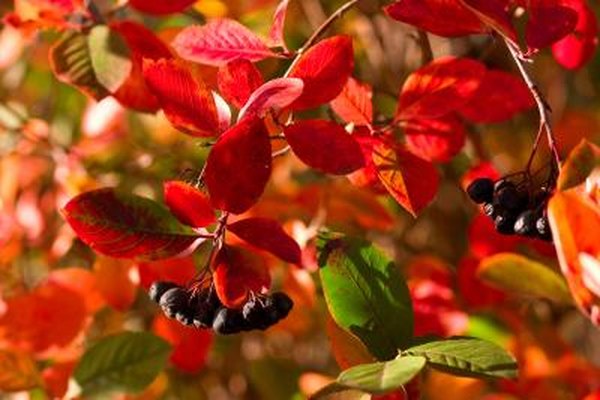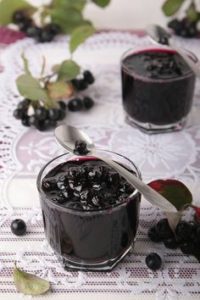
PLANT FACTS
Chokeberry (Aronia) is a woody, perennial shrub native to the swampy woodlands of eastern North America that produces clusters of red or dark purple, dime-size berries in late summer and early fall. When eaten raw, the berries can be very astringent — hence their common name ‘chokeberry.’ But don’t let the name fool you! Studies show these berries are a superfruit containing more antioxidants than any other berry, including blueberries, pomegranate, acai, goji, or mangosteen! Aronia belongs to the rose (ROSACEA) botanical family, which also includes fruits such as cherries, apples, and pears. Depending on the cultivar, it can grow to be 10 ft tall and 6 ft wide, although most grow into open, rounded shrubs with some degree of suckering. Aronia plays an important role in indigenous traditions and foodways with various uses in food, teas, and as a dye. It’s frequently found in urban settings as an ornamental shrub because of its beautiful, white spring blossoms and fire-red-orange foliage that develops in the fall. Black Chokeberry (Aronia melanocarpa) is said to possess more edible/medicinal properties; while Red Chokeberry (Aronia arbutifolia) has higher ornamental appeal.

SEASONAL CARE
Aronia is a hardy and easy to grow shrub adapted to climate zones 3-9. It can tolerate wet and dry soil and a wide range in temperatures. Will grow happily in partial shade but produces best in 6 or more hours of direct sunlight. This native plant is relatively pest and disease resistant. Aronia is self-fertile and will produce berries as a single plant.
WINTER/SPRING: Pruning is not necessary but can be done in the plant’s dormant period. As with any berry-producing shrubs, prune out several of the oldest stems each winter to rejuvenate the plant and ensure best production. Renewal pruning begins in around the 4th year after planting and should not exceed 25% of the wood removed in a season.
SUMMER: Water twice a week the first summer until the new roots have established. Berries are edible when they begin to turn color, however, antioxidant levels increase and the flavor becomes more palatable the longer they are left on the bush.
FALL: Harvest and process the berries mid-September and get ready to enjoy the fire red foliage!
NUTRITIONAL BENEFITS
Aronia is packed with nutrients, including zinc, magnesium, iron, and vitamins C, B, and K. As noted before, they are considered a superfruit containing the most antioxidants of all berries. Antioxidants are known to inhibit oxidation and reduce free radicals in the body, inhibiting cancer. Studies have shown it can be an effective aid for helping to manage diabetes, positively influencing insulin levels, immune system, and inflammation. Studies have also shown positive effects on the cardiovascular system, liver, stomach lining, and urinary system. It is highly recommended that aronia berries are processed into syrups, jams, teas, juices or pies, before consumption tor remove astringency. The berries can also be dried or frozen.

PROPAGATING ARONIA SHRUBS
As a shrub with natural suckers, the plant does well with root divisions. It is recommended to propagate by ground-layering: build up the soil around a sucker’s base so roots form, allowing the sucker to eventually be cut off to form its own independent plant. Make sure to water twice a week in the plant’s first summer to ensure success.
Aronia Recipes!
1. Smoothie
Blend together and serve immediately:
3-4 bananas
1 cup plain yogurt or kefir
1 – 1 1/2 c. coconut milk (or other milk)
1 cup frozen aronia berries
1 cup frozen raspberries or other fruit
This POP Blog Post was prepared by 2018 POP Orchard Intern Greg Hample and Admin Assistant Natalie Agoos.
SUPPORT US! If you found this entry useful, informative, or inspiring, please consider a donation of any size to help POP in planting and supporting community orchards in Philadelphia: phillyorchards.org/donate.
